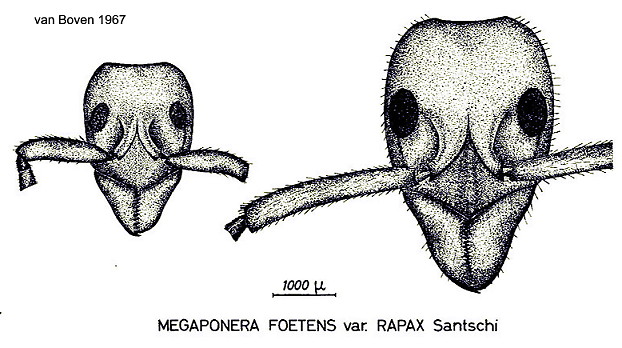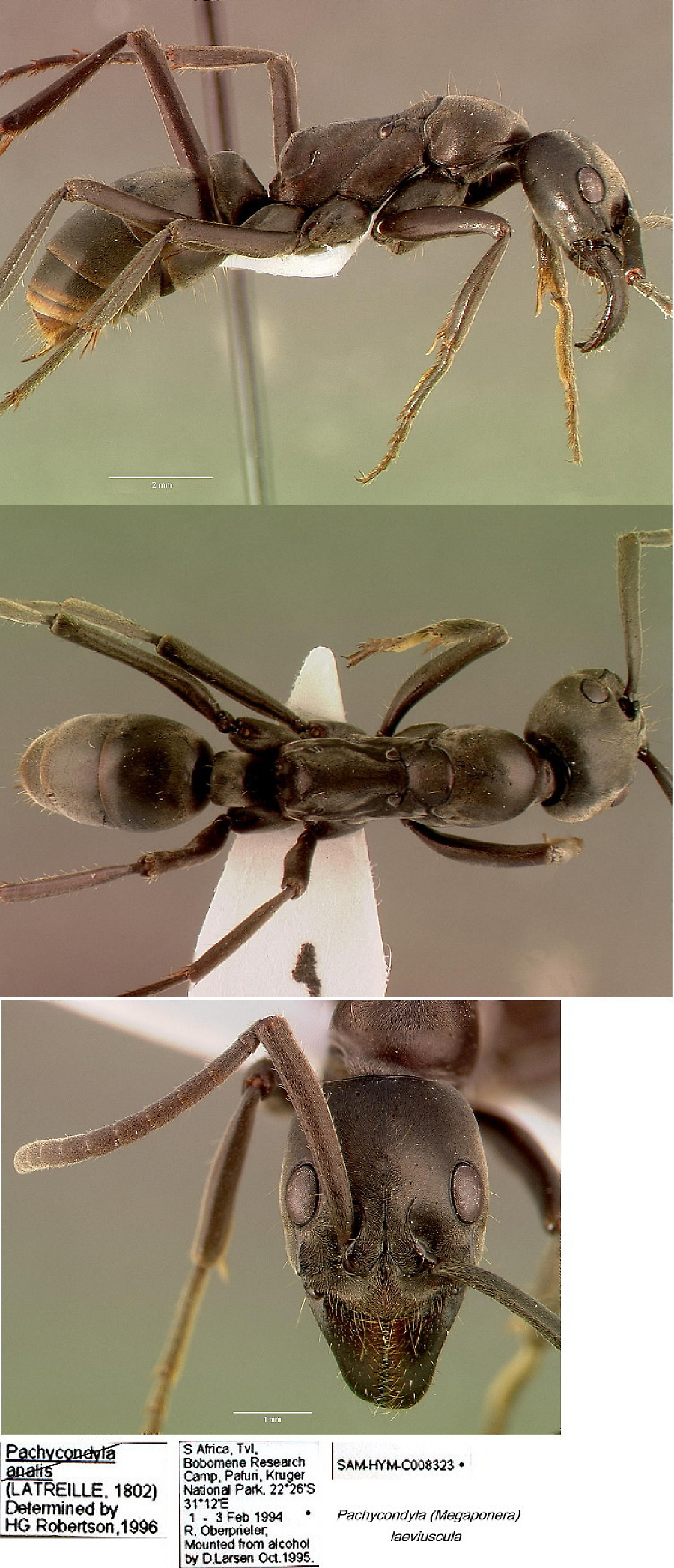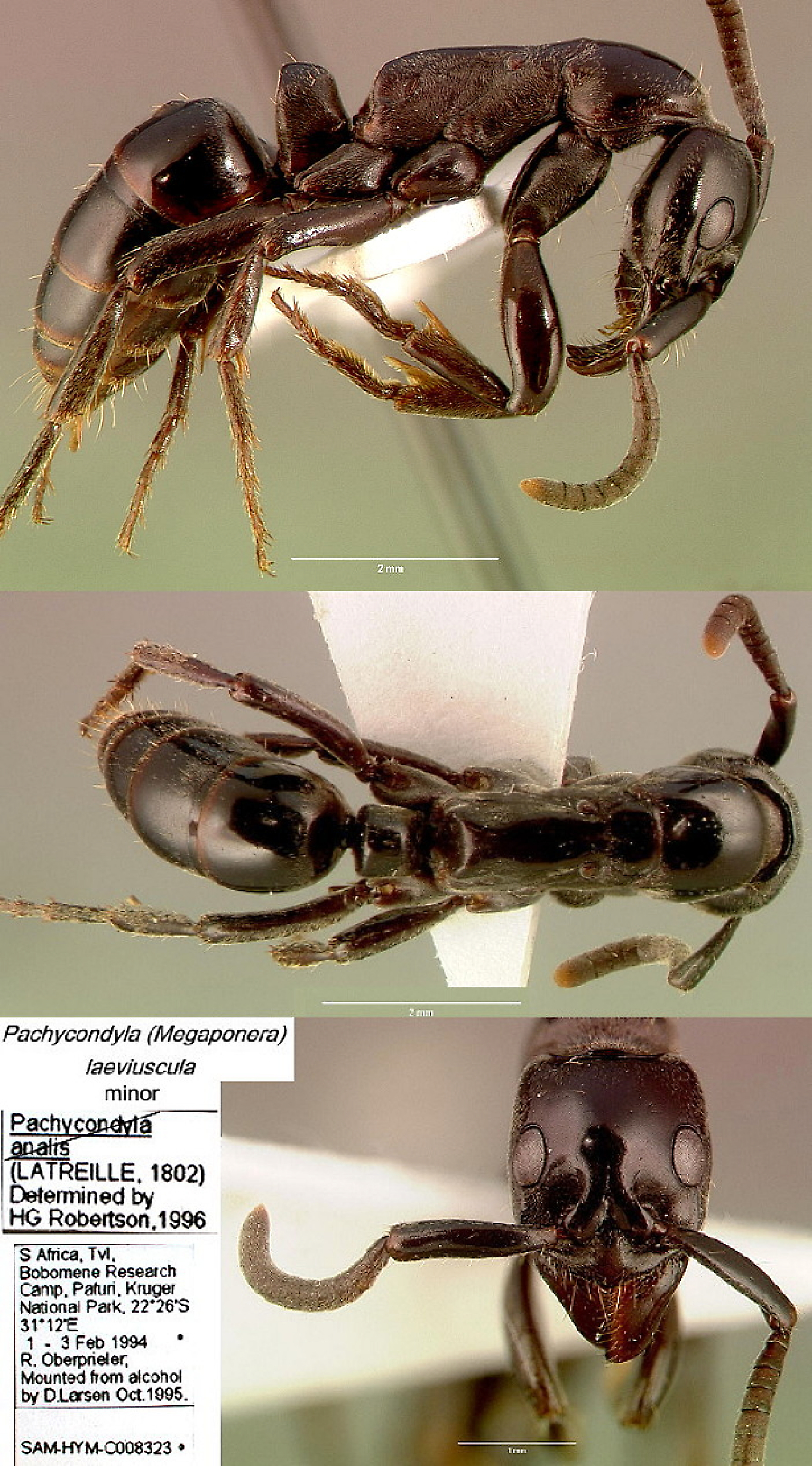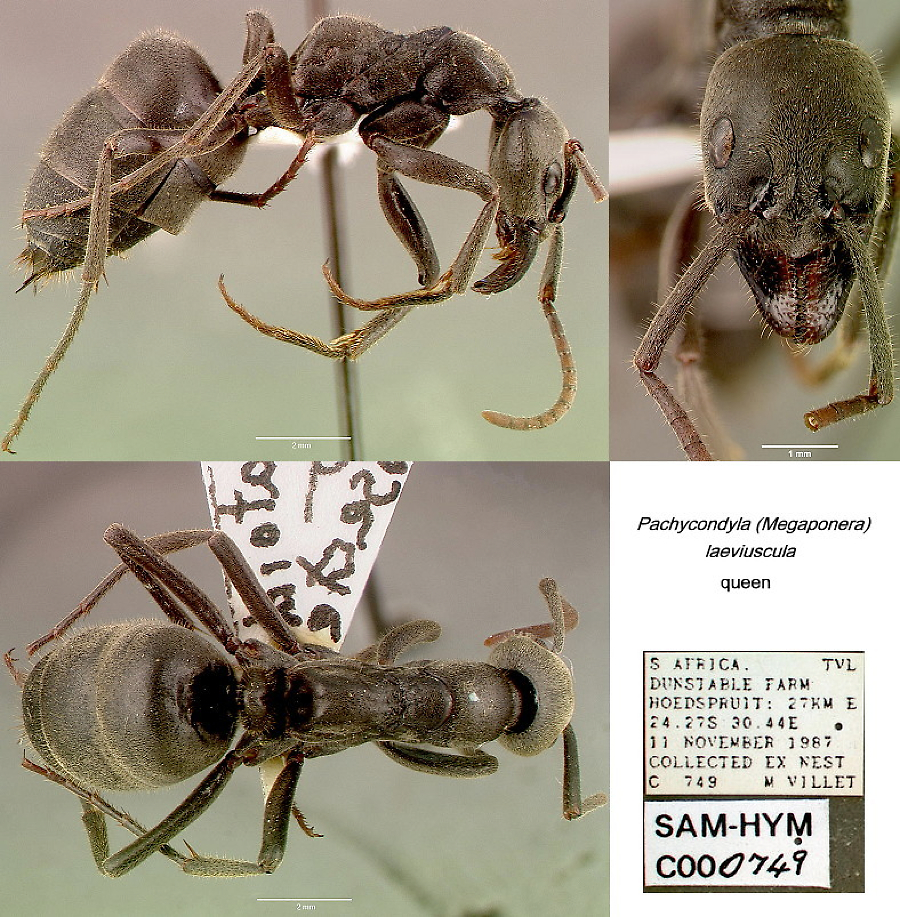Pachycondyla (Megaponera) laeviuscula
(Gerstaecker) - speculative revived status - subject to confirmation
  Type location Mozambique
(Ponera laeviuscula n. sp., Gerstäcker, 1859: 262, worker; not listed by Schmidt & Shattuck, 2014: 107) - no images on Antweb (June 2014). Type location Mozambique
(Ponera laeviuscula n. sp., Gerstäcker, 1859: 262, worker; not listed by Schmidt & Shattuck, 2014: 107) - no images on Antweb (June 2014).
subspecies
crassicornis (Ponera crassicornis n. sp.,
Gerstäcker, 1859: 262,
worker; listed under analis by Schmidt & Shattuck, 2014: 107) from Mozambique - no images on Antweb (June 2014).
rapax (Megaponera foetens
(Fabricius) var. rapax, nov., Santschi, 1914b: 49, worker; listed under analis by Schmidt & Shattuck, 2014: 107) from
Tanzania, Kilimanjaro - no images on Antweb (June
2014)
subpilosa (Megaponera foetens F. v. subpilosa n. v., Santschi, 1937d:
217,
worker; listed under analis by Schmidt & Shattuck, 2014: 107) from Angola, Ebanga - no images on Antweb (June 2014)
termitivora (Megaponera foetens F. var. termitivora
n. var., Santschi, 1930b:
60, worker; listed under analis by Schmidt & Shattuck, 2014: 107) from Zaïre, Banana - see below
 . .
|
 Gerstäcker's
(1859) descriptions of crassicornis and laeviuscula are
at Gerstäcker's
(1859) descriptions of crassicornis and laeviuscula are
at  . Arnold (1915: 46) using
the name foetens gave translations and notes; these are at . Arnold (1915: 46) using
the name foetens gave translations and notes; these are at  and and  (sexual forms). Santschi's (1914b)
description of rapax is at (sexual forms). Santschi's (1914b)
description of rapax is at  . Santschi (1930b) described termitivora
but curiously revived crassicornis in a key at . Santschi (1930b) described termitivora
but curiously revived crassicornis in a key at  . Santschi (1937d) described subpilosa
at . Santschi (1937d) described subpilosa
at  . Boven (1967b) made a
comparative study of the morphometrics of rapax, this is at . Boven (1967b) made a
comparative study of the morphometrics of rapax, this is at  . .
In his short description, Gerstaecker (1859) states the
petiole is abbreviated and raised; also he refers to the grey
pubescence. With the minor, crassicornis, he notes the
mandibles, antennae and legs as rufo-piceous [in the minor of analis.
these are almost uniformly dark red-brown].
Forel (1909b: 64) related how it was Mayr (1907) who
showed that Megaponera crassicornis Gerst. was not a species
but was the worker minima of M. foetens. Similarly, Emery had
given the name M. dohrni to a form intermediate between foetens
and crassicornis but this was the intermediate or median form.
Mr Creighton Wellman, collecting in Benguela, had found all the forms
together. Creighton Wellman also had confirmed that the species moved
in an Army Ant manner, with numerous individuals. Forel (1911d) noted
Prell had observed the single file, army ant activity, mostly carrying
dead workers or soldiers of termites, with the loud stridulation and
strong odour of bitter almonds. Wheeler (1922) gave much detail on its
termitophagic habits and how it migrated in columns, citing
observations in East Africa. Compare with Pachycondyla analis.
|
 Boven
(1967b) examined specimens of "Le variété rapax" from Angola
and commented on the pilosity on
tibiae and dorsal alitrunk. He also noted a longitudinal groove on the
propodeum of major workers that was not found in the type P. foetens.
His other descriptive notes, such as the shininess of the minor match
the specimens shown below. It appears that he concluded the species
shows true dimorphism. Boven
(1967b) examined specimens of "Le variété rapax" from Angola
and commented on the pilosity on
tibiae and dorsal alitrunk. He also noted a longitudinal groove on the
propodeum of major workers that was not found in the type P. foetens.
His other descriptive notes, such as the shininess of the minor match
the specimens shown below. It appears that he concluded the species
shows true dimorphism.
The recent (2005) BBC TV series "Life in the
Undergrowth" part 4, included excellent footage on the attacks of
"Matabele Ants" on termite mounds.
|
 The
photomontage of the termitivora type worker is collated from http://www.antweb.org/specimen.do?name=rmca000017725. The
photomontage of the termitivora type worker is collated from http://www.antweb.org/specimen.do?name=rmca000017725.
|
 This photomontage
of a major worker is collated from http://www.antweb.org/specimen.do?name=sam-hym-c008323b.
Collection Information: SAM-HYM-C008323B; Locality South Africa:
Transvaal: Bobomene Research Camp, Pafuri, Kruger National Park;
22°26'00"S 031°12'00"E 250 m; Collection codes: SAM-HYM-C008323 Date:
1-3 Feb 1994; Collected by: R.G.Oberprieler This photomontage
of a major worker is collated from http://www.antweb.org/specimen.do?name=sam-hym-c008323b.
Collection Information: SAM-HYM-C008323B; Locality South Africa:
Transvaal: Bobomene Research Camp, Pafuri, Kruger National Park;
22°26'00"S 031°12'00"E 250 m; Collection codes: SAM-HYM-C008323 Date:
1-3 Feb 1994; Collected by: R.G.Oberprieler
Note - I have corrected this page with the help of
Marcus Stuben (1 July 2009)
|
 This photomontage
of a minor worker (possibly the subpilosa
of Santschi, 1937d) is collated from http://www.antweb.org/specimen.do?name=sam-hym-c008323a.
Collection Information: SAM-HYM-C008323A; Locality South Africa:
Transvaal: Bobomene Research Camp, Pafuri, Kruger National Park;
22°26'00"S 031°12'00"E 250 m; Collection codes: SAM-HYM-C008323 Date:
1-3 Feb 1994; Collected by: R.G.Oberprieler This photomontage
of a minor worker (possibly the subpilosa
of Santschi, 1937d) is collated from http://www.antweb.org/specimen.do?name=sam-hym-c008323a.
Collection Information: SAM-HYM-C008323A; Locality South Africa:
Transvaal: Bobomene Research Camp, Pafuri, Kruger National Park;
22°26'00"S 031°12'00"E 250 m; Collection codes: SAM-HYM-C008323 Date:
1-3 Feb 1994; Collected by: R.G.Oberprieler
|
 The photomontage
of a queen is collated from http://www.antweb.org/specimen.do?name=sam-hym-c000749b The photomontage
of a queen is collated from http://www.antweb.org/specimen.do?name=sam-hym-c000749b
Collection Information: Specimen Code SAM-HYM-C000749B; Locality South
Africa: Transvaal: Dunstable Farm, 27 km E of Hoedspruit; 24°27'00"S
030°44'00"E; Collection codes: SAM-HYM-C000749; Date: 11 Nov 1987;
Collected by: M.H.Villet.
|
|